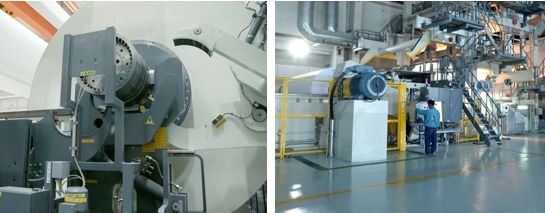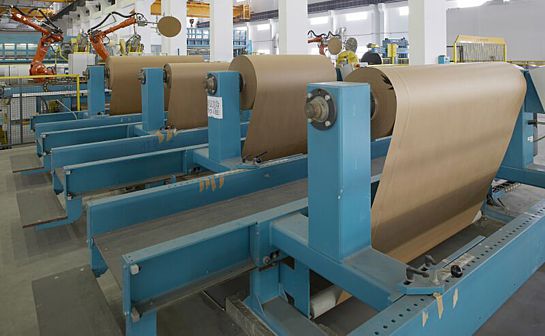Preventive unwind stand maintenance reduces waste and downtime
Feb 20, 2018
Running day in and day out, the unwind is responsible for several functions in the finishing process, including supercalendering, coating, and rewinding paper into a denser, more stable roll. During operation, it endures constant tension, high speed and vibration, which slowly take their toll. Unfortunately, the unwind stand often runs neglected until the unit breaks down or needs replacement.
While component failure and replacement are inevitable, the operating life of the unwind can be lengthened through scheduled maintenance and optical alignment. These procedures assure a higher quality product with less waste and reduced downtime.

Multinip calender (left) and offline coater (right) unwind stands
The key areas of concern for unwind maintenance are tension control, clutch backlash and the emergency stop brake.
Tension control
The unwind must maintain constant and consistent web tension to ensure a top-quality finished product. Poor tension control causes web breaks and reduces roll quality.
A computer analysis of unwind tension, provided by a data acquisition specialist, reveals tension variations by plotting both the unwind tension and winder speed, then analyzing how tension behaves during a change in speed. If significant variations in tension exist during any speed shifts, the machine is either improperly tuned or not designed for the current operating conditions.
Tension control and tension levels depend on paper grades. An unwind stand equipped with a mechanical brake can only go to zero during acceleration, which limits the rate of acceleration. However, many modern machines now use a regenerative drive that is capable of motoring, allowing for faster acceleration rates at a smaller degree of variation. High-performance regenerative drives provide control to 1 percent or better of running tension.
Maintaining proper tension control should also include:
- Keeping a drive log. Log any drive adjustments and monitor changing operating conditions after a drive is re-tuned. Errors made while tuning a drive are often not apparent until later. For example, when a drive accelerates, there may be an abrupt change in velocity as the drive reaches a constant speed. This change in acceleration will create a momentary loss of tension that could break the web, produce a wrinkle, or cause the roll to lose control, making the web flutter from side to side. This tension behavior probably indicates the drive's S-ramp was not properly tuned for a smooth transition.
- Checking for loose saddles and reels. Saddles and reels also have an effect on the unwind and the precision with which the tension system and the drive can be calibrated. Periodic inspections every three months will detect if components are worn, and reveal whether replacement will be necessary. Worn reel spool bearings will upset tension control to the point of losing web control altogether. When reel spools rock and shift in the saddle, it is a good indicator the saddles are worn, making tension control difficult with the unwind brake or regenerative drive. For optimum tension control, it is also important to ensure the reel spool is not bent and is properly aligned.

Roll wrappers have multiple unwind stands.
Minimizing clutch backlash
A key maintenance concern, which also impacts tension control, is clutch backlash. Ensuring a properly maintained clutch will discourage backlash and prolong clutch life. Backlash, or the "dead zone" that occurs during a change in speed, quickly erodes the clutch and can produce extreme tension variations, resulting in a web break. The most common type of clutch resembles a block with a square hole and a matching square coupling. Ideally, to prevent backlash, the two clutch parts would fit tightly together, but such a close fit is impractical. Some clearance is required to enable the clutch to be operational. As the gap between the coupling and fitting widens due to wear, backlash increases. Extreme backlash makes the clutch slightly reverse itself during a change in speed. Noise generated by a vibrating clutch indicates the clutch is worn, which can cause tension spikes and, ultimately, a web break. Inevitably, the entire clutch will need to be replaced, but replacing the block and coupling once they start to wear costs less in the long run, since waiting only guarantees additional downtime while paper and roll quality suffer.
Emergency Stop Brake
Another key maintenance concern is the emergency stop brake, which must quickly halt the reel following a web break to reduce paper loss. Poorly calibrated brake shoes and worn shoe pads reduce the emergency stop brake's effectiveness.
Brake friction wears show pads, increasing the clearance required by the model specifications. Clearance may range from 1/16 of an inch, the most common, to 1/32 of an inch. A 1/8- to 1/4-inch gap between shoes and the drum will delay the brake's engagement - a problem easily prevented with periodic maintenance checks.
Alignment
Even a properly maintained machine cannot deliver quality paper if poor web alignment exists from the unwind to the winder. The moment machinery is aligned, vibration slowly shakes it out of alignment. In severe cases, vibration can loosen restraining bolts, causing the unwind stand to shift slightly.
In addition to vibration, several incidental factors contribute to misalignment. For example, a forklift may inadvertently bump the unwind stand, or a reel may accidentally hit the unit while being loaded by a crane.
Though most alignment problems cannot be detected by the eye, close observation can spot gross web misalignment. If the lead-in roll is in zero position, the web is pulled tight and wrinkles emanate from the unwind to the winder, one of the web carrying rolls or the reel itself may be out of alignment.
Reverse the reel on the unwind to confirm misalignment. If wrinkles appear on the opposite side, it is probably a paper problem. If the wrinkles remain on the same side, the winder or the unwind, or both, may be misaligned and require an optical check.
The rewind section should be optically checked for alignment every six months, even if no clues exist to indicate something is wrong. Since after a year some alignment adjustments are always necessary, annual optical checks should be mandatory.
For more information on unwind stand maintenance and upgrades, contact your Valmet representative.